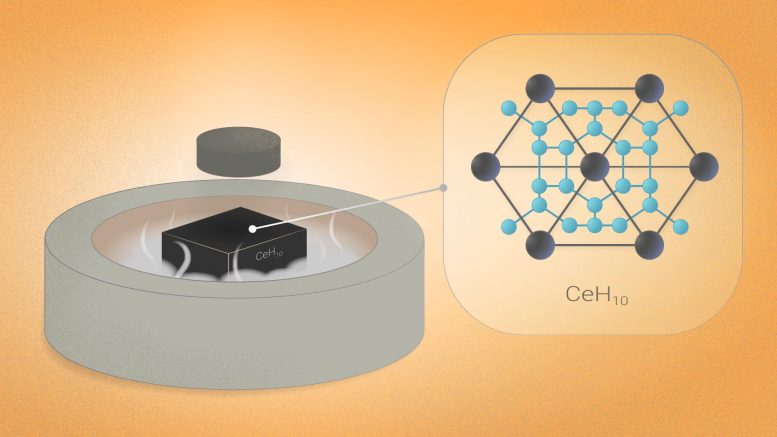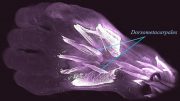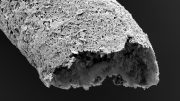
Structure of cerium superhydride CeH10 synthesized by the researchers and shown to be a high-temperature superconductor. Credit: Pavel Odinev/Skoltech
New cerium superhydrides become stepping stones to “Goldilocks” superconductors.
Researchers from Skoltech and their colleagues from China have experimentally shown superconductivity in cerium superhydrides CeH9 and CeH10, pointing the way to lower-pressure and potentially room-temperature superconductors. The paper was published in the journal Physical Review Letters.
The road to superconductivity, an extremely attractive physical property of some materials that do not lose energy to heat because they have zero resistance, lies through tough terrain. It requires either extremely low temperatures (we’re talking 135 K, or minus 138 degrees Celsius or minus 261 Fahrenheit, at the warmest) or extremely high pressure (in 2019, LaH10 was found to become superconducting at -23 C or -9.4 F and 1.7 million atmospheres, and in 2020 a S-C-H compound was found to superconduct at +15 C or 59 F and 2.7 million atmospheres). Scientists are working to “normalize” superconductors, looking for compounds that would have this property at close to room temperature and a somewhat less terrifying pressure.
Continuing the long-running quest that combined theory and experiment, Skoltech Professor Artem R. Oganov and PhD student Dmitrii Semenok joined forces with the team of Professors Tian Cui, Xiaoli Huang (Jilin University) and PhD student Wuhao Chen. This team has demonstrated superconductivity in CeH9, a cerium superhydride they had discovered earlier in 2019, and in the newly synthesized CeH10.
“Cerium hydrides are remarkable compounds. Stable and displaying high-temperature superconductivity at lower pressures than any other superhydrides (about 0.8 million atmospheres), they serve as an ideal starting point to further study the mechanism of superconductivity in these fascinating compounds, and design other superconductors, stable at even lower pressures,” the authors write.
“Earlier we established a remarkably close relationship between the periodic table and superconductivity of hydrides — and we believe it should apply not just to hydrides! Take La and Ce — they are neighbors in the periodic table and indeed both form high-temperature superconductors. However, there are differences: LaH10 superconducts at higher temperatures, while CeH10 is stable at lower pressures,” Artem R. Oganov says.
The authors point out that now binary hydrides are mostly explored. “Now we need to carefully think how to combine the elements to achieve higher-temperature superconductivity at lower pressures in ternary hydrides. We know which elements lead to higher-temperature superconductivity and begin to learn which lead to stability at lower pressures. These are the main notes, but it takes imagination to combine them in a melody,” Dmitrii Semenok adds.
Credit: “High-Temperature Superconducting Phases in Cerium Superhydride with a Tc up to 115 K below a Pressure of 1 Megabar” by Wuhao Chen, Dmitrii V. Semenok, Xiaoli Huang, Haiyun Shu, Xin Li, Defang Duan, Tian Cui and Artem R. Oganov, 9 September 2021, Physical Review Letters.
DOI: 10.1103/PhysRevLett.127.117001
Other organizations involved in this research include Jilin University, Ningbo University, and the Center for High Pressure Science and Technology Advanced Research.









Substituting one constraint for another ie temperature for pressure doesn’t help to make any applications practical.
There is a new constraint added since the 1980s and that is Moore’s law. The last time IBM had a presence in superconducting JJ devices and made a tiny computing device (a 4bit device iirc) and some memory was back when silicon was running on 5u process and DRAM had reached 4KBits. Semiconductor advancements allowed silicon to fall down a rapidly accelerating path of for ever shrinking. That could never happen to old JJ devices because of the liquid helium drivem temperature cycling. Even if temperature was a constant room level, I doubt superconducting chips would even scale much more than was done in the 80s. The technology is so far behind we can forget about superconducting chips. And besides, all the worlds fastest computers have used mainstream technology for 3 decades now, they are not going back to proprietary chip processes and architectures, it’s always about commodity volume manufacturing.
But there is always a potential for use in medical scanning devices and HVDC power transmission where chip scaling is not an issue.
Sea-cast windmill turbines would do well to work with superconducting stators, and if that means the area’s ripe for supercomputing of any variety, some way to keep service areas from claustrophobia or into robot service will avail. 3 GPa service pressures and hydride lattice to take it, all very sporting.
Room Temperature is 20C Try again goldilocks…